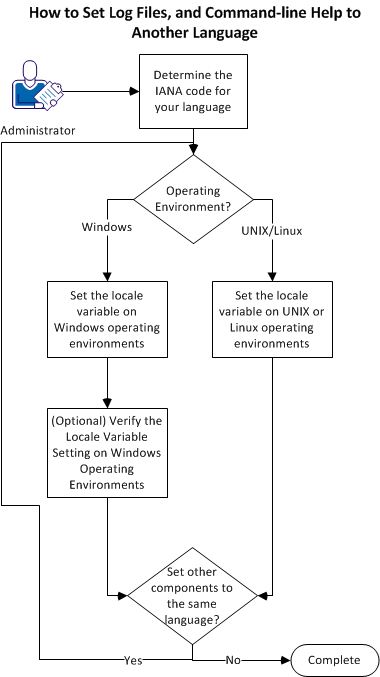

The following components support log files, and command-line help in other languages:
The following graphic describes the work flow for setting log files, and command-line help to another language:

Follow these steps:
Each language has a unique code. The Internet Assigned Numbers Authority (IANA) assigns these language codes. Adding a language code to a locale variable changes the language that the software displays. Determine the proper code for the language that you want before creating the locale variable.
The following table lists the IANA codes that correspond to the languages supported by the software:
|
Language |
IANA Code |
|---|---|
|
Brazilian Portuguese |
pt_BR |
|
French |
fr |
|
German |
de |
|
Italian |
it |
|
Japanese |
ja |
|
Korean |
ko |
|
Simplified Chinese |
zh-Hans |
|
Spanish |
es |
Note: A list of IANA language codes is available from this third-party website.
The environment variables are settings by which users can customize a computer to suit their needs. Examples of environment variables include the following items:
Windows operating environments allow global environment variables, which apply to all users of a computer. The environment variables on UNIX or Linux operating environments must be set for each user or program.
To set the locale variable, pick the procedure for your operating environment from the following list:
The following locale variable specifies the language settings for the software:
SM_ADMIN_LOCALE
Create this variable and set it to the language that you want. Set this variable on each component for which you want to use another language. For example, suppose you want to have a Policy Server and an agent that is set to French. Set this variable on both of those components to French.
Note: The installation or configuration programs do not set this variable.
The system properties dialog appears.
The New System Variable dialog opens with the cursor in the Variable name: field.
SM_ADMIN_LOCALE
The New System Variable dialog closes and the SM_ADMIN_LOCALE variable appears in the list.
The locale variable is set.
You can very the value to which the locale variable is set at any time. You can do this procedure after setting the variable to confirm that it is set correctly.
Note: Instructions for verifying the variable value on UNIX and Linux are in the setting procedure.
Follow these steps:
cmd
A command-line window opens.
echo %SM_ADMIN_LOCALE%
The locale appears on the next line. For example, when the language is set to German, the following code appears:
de
The value of the locale variable is verified.
The following locale variable specifies the language settings for the software:
SM_ADMIN_LOCALE
Create this variable and set it to the language that you want. Set this variable on each component for which you want to use another language. For example, suppose you want to have a Policy Server and an agent that is set to French. Set this variable on both of those components to French.
Note: The installation or configuration programs do not set this variable.
Follow these steps:
export SM_ADMIN_LOCALE=IANA_language_code
The command in the following example sets the language to French:
export SM_ADMIN_LOCALE=fr
The locale variable is set.
echo $SM_ADMIN_LOCALE
The locale appears on the next line. For example, when the language is set to German, the following code appears:
de
|
Copyright © 2013 CA.
All rights reserved.
|
|